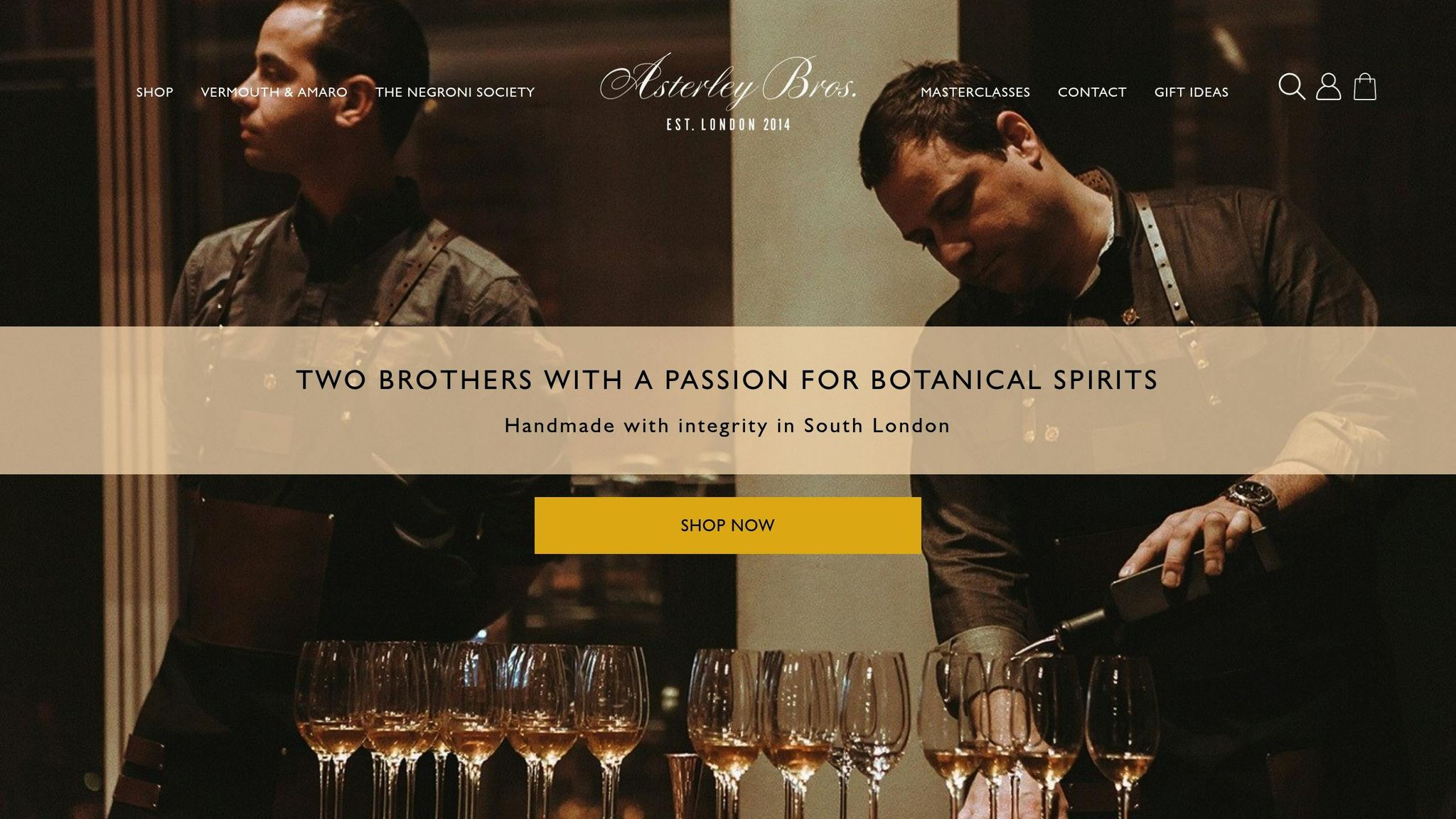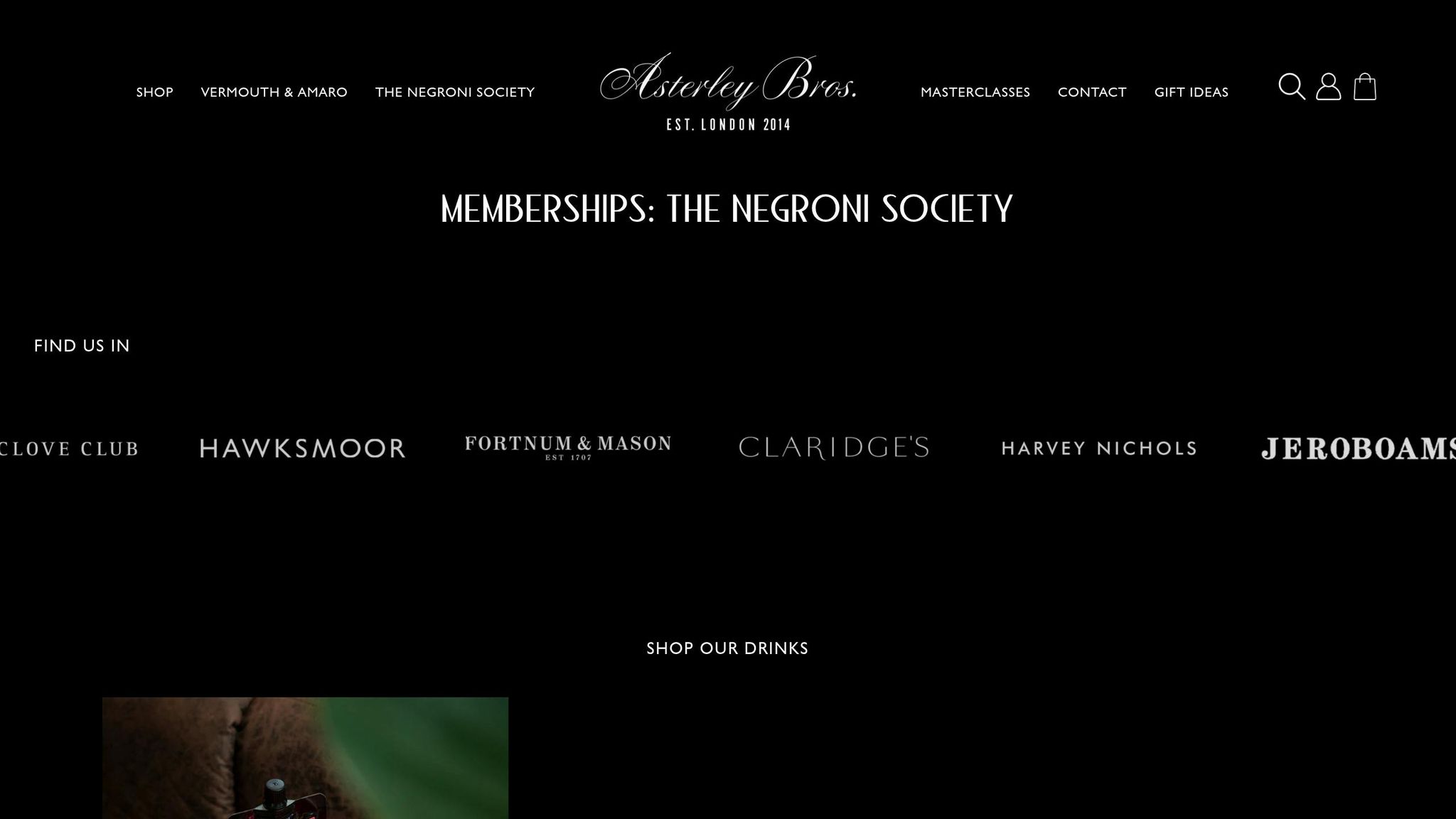The origins of vermouth and amaro lie in ancient herbal remedies. These drinks, now enjoyed socially, were once medicinal solutions crafted by civilisations like the Egyptians, Greeks, and Romans. Alcohol served as a solvent for extracting healing compounds from botanicals, making these infusions effective treatments for digestion and other ailments.
Key points:
- Ancient uses: Egyptians, Greeks, and Romans infused wine with herbs for health benefits.
- Wormwood's role: Central to vermouth, it aided digestion and inspired its name.
- Monastic medicine: Middle Ages monks refined herbal remedies into tinctures, precursors to modern vermouth and amaro.
- Renaissance shift: Apothecaries sold herbal tonics, evolving them into recreational beverages by the 18th century.
- Modern transition: Vermouth became a pre-meal aperitif, while amaro turned into an after-dinner digestif.
Today, producers like Asterley Bros in the UK honour this history by blending traditional botanical knowledge with British ingredients. Vermouth and amaro have evolved from ancient remedies to sophisticated drinks, preserving their medicinal heritage in every sip.
Learning About Vermouth
Early History of Herbal Wine Remedies
The tradition of blending wine with medicinal herbs stretches back thousands of years. Early hunter-gatherer societies crafted wine-like beverages infused with botanicals for rituals, ceremonies, and healing purposes. These communities discovered that wine served as an effective carrier for medicinal compounds, laying the groundwork for more sophisticated uses by ancient civilisations.
Herb-Infused Wines in Ancient Medicine
The Ancient Egyptians were pioneers in documenting the use of herbal wine remedies. As far back as 3150 B.C., they infused grape wine with herbs and resins. Chemical analyses of pottery from this era confirm traces of these natural substances. They utilised a wide array of botanicals, including coriander, lemon balm, peppermint, rosemary, sage, savory, senna, and thyme.
The Phoenicians also practised herbal wine-making, as evidenced by residues found in their ancient wine vessels. These mixtures weren't just for enhancing flavour; they transformed wine into a medicinal tool by infusing it with healing herbs and spices.
Greek physicians advanced these practices further. Dioscorides, in his De materia medica (c. 40–90 CE), documented how different liquids - like water, vinegar, honey, or wine - could influence a herb's effectiveness. For instance, he noted thyme's varying benefits for digestive troubles and nervous conditions depending on the preparation method.
The Romans took these ideas to new heights, combining wine with water and spicing it with herbs like wormwood to improve digestion and mask the taste of lower-quality wines. They recognised that alcohol acted as a powerful solvent, drawing out the active compounds from herbs. Their method of soaking herbs in wine resembled modern tincture-making techniques. Before synthetic medicines, these herbal infusions were widely regarded as universal remedies. Wormwood, in particular, became central to many treatments.
Wormwood in Early Medical Treatments
Ancient medical texts by Hippocrates and Galen highlight wormwood's importance in treating digestive issues and liver problems. Egyptian medical writings also describe its use for relieving stomach ailments and expelling intestinal parasites. Greek physicians often prescribed wormwood-infused wines to stimulate appetite, ease digestive discomfort, and support liver health. Beyond its medicinal uses, the Greeks considered wormwood a multi-purpose remedy, employing it as a cure-all, aphrodisiac, and digestive aid. This focus on wormwood eventually inspired the creation of vermouth, a name derived from the German word "wermut", meaning wormwood.
The Romans adopted these practices and refined them further, balancing wormwood's bitterness with wine to retain its therapeutic qualities while making it more palatable. The herb's enduring significance is reflected in its linguistic legacy, with vermouth paying homage to its ancient medicinal origins.
European Apothecaries and Early Vermouth Development
During the Renaissance, European apothecaries took the art of herbal wine-making to new heights, building on age-old traditions of wormwood-infused wines. In Italy, these skilled practitioners transformed these ancient recipes into medicinal brews, gradually shaping what would eventually become vermouth. This shift marked vermouth's evolution from a health tonic to a refined social drink.
From Medical Tonics to Early Vermouth
In the 15th and 16th centuries, Italian apothecaries perfected the craft of herbal wine-making by using advanced extraction techniques to draw out medicinal properties. Their workshops were equipped with distillation tools and other specialised equipment, showcasing a systematic approach that distinguished them from ancient herbalists.
Piedmont, strategically located along Alpine trade routes, became a melting pot where local Alpine herbs met exotic imported spices. This unique blend of ingredients gave rise to balanced and therapeutic formulations.
Initially valued for their ability to stimulate appetite and aid digestion, these herbal wines began to gain popularity as aperitifs, appreciated for their complex and appealing flavours. These advancements laid the groundwork for vermouth's transformation into a commercial success.
Antonio Benedetto Carpano and Commercial Vermouth Production
In 1786, Antonio Benedetto Carpano opened a shop in Turin's Piazza Castello and revolutionised vermouth production. With his background in apothecary methods, he introduced standardisation and mass production to herbal wines.
Carpano's recipe blended local Moscato wine with a carefully curated mix of botanicals, including wormwood, cardamom, cinnamon, and Alpine herbs. This ensured consistent quality and elevated vermouth from a medicinal remedy to a sophisticated beverage enjoyed in social settings.
Amaro: From Monastery Medicine to Digestive Drinks
As vermouth was becoming a commercial staple in Turin, another tradition was quietly thriving in Italy's 13th-century monasteries. Here, monks carefully preserved herbal knowledge and crafted remedies that would later evolve into what we now know as amaro. These early concoctions were shaped by Italy's diverse climates and the unique plants found in each region.
Monastery gardens became laboratories of sorts, where monks experimented with local herbs and botanicals. Their aim was to harness the properties of bitter plants, refining techniques that would eventually define the distinctive character of amaro.
Regional Italian Amaro Recipes
The variety of herbs available across Italy's regions led to a wide range of amaro recipes. Each blend reflected the local environment, showcasing the monastic tradition of tailoring remedies to the resources at hand.
Amaro for Digestive Health
These regional variations weren't just about flavour - they were deeply rooted in the belief that bitter herbs could aid digestion. Monastic healers valued these tonics for their supposed health benefits, particularly their ability to support digestive health. Over time, these medicinal brews transformed into beverages enjoyed not just for their restorative qualities but also for their unique taste.
sbb-itb-f74956d
From Medicine to Aperitivo: The Social Transformation
After exploring vermouth's and amaro's medicinal roots, let's dive into their fascinating evolution into social drinks. This transformation didn't occur overnight but mirrored the sweeping societal changes of 18th- and 19th-century Europe. As urbanisation took hold and social customs evolved, new opportunities for leisure and gathering emerged, setting the stage for these botanical tonics to transition from apothecaries to cafés.
The key turning point came when these concoctions left the medicinal realm and entered the social scene. In Italy, the concept of the aperitivo was born in the late 1700s, establishing a ritual that seamlessly combined ancient herbal traditions with the pleasures of modern socialising.
How Aperitivo Culture Developed
The aperitivo tradition stemmed from a simple observation: bitter botanical drinks seemed to awaken the appetite when enjoyed before meals. In the cafés of Turin, vermouth became a pre-dinner favourite, sparking a trend that would ripple across Europe and beyond.
It was in Turin that Carpano's establishment popularised the ritual. Merchants and professionals would gather for a glass of vermouth, transforming it into a daily social practice. By the mid-19th century, as café culture flourished, this habit evolved further. Cafés started pairing vermouth with small food plates, giving rise to the modern aperitivo tradition. This pre-dinner window, typically between 18:00 and 20:00, became a cherished moment to unwind and connect before the evening meal.
One of the most iconic milestones in this transformation was the creation of the Negroni in Florence around 1919. Count Camillo Negroni requested a stronger version of the Americano cocktail, swapping soda water for gin. The result was a perfectly balanced blend of bitter, sweet, and botanical flavours, embodying the sophistication of vermouth's new role in social drinking culture.
Amaro as an After-Dinner Drink
While vermouth established itself as the drink of choice before meals, amaro found its place as the perfect way to end them. Its journey from monastic medicine to after-dinner staple mirrored changing attitudes in 19th-century Italy, where health and pleasure began to intertwine.
The custom of enjoying amaro after meals started in Italian households during the 1800s. Families served it after Sunday dinners, blending its digestive benefits with the pleasure of marking the meal's conclusion. Over time, this tradition expanded to restaurants and cafés.
Regional pride played a big part in amaro's rise. Different regions developed their own varieties, each fiercely championing the unique flavours and digestive benefits of their local creations. This regional identity turned amaro into more than just a herbal remedy - it became a symbol of its place of origin, with each bottle telling a story of local traditions and ingredients.
With industrialisation in the late 19th century, amaro became more widely available and firmly established its role in social life. Brands like Averna (founded in 1868) and Ramazzotti (established in 1815) began promoting their products as more than just digestive aids; they became sophisticated beverages for social occasions.
Today, amaro's complexity and versatility continue to captivate. Bartenders prize it for adding depth to cocktails, while diners relish its ability to round off a meal with a bitter-sweet flourish. Whether sipped as a digestif or used creatively in mixology, amaro remains a refined choice for those seeking both flavour and tradition.
This transformation highlights a broader shift in how we view botanical beverages. What started as closely guarded herbal remedies has become a celebration of regional identity, culinary artistry, and shared experiences. The aperitivo and digestivo traditions we enjoy today are steeped in centuries of botanical wisdom, now wrapped in the joy of social connection and cultural heritage.
Modern UK Vermouth and Amaro Production
In recent years, the UK's botanical spirits scene has seen a resurgence, with producers reimagining the age-old medicinal traditions of vermouth and amaro. This revival isn’t just about recreating historical recipes - it’s about celebrating botanical heritage while incorporating modern techniques and showcasing British ingredients. By blending tradition with innovation, contemporary craft producers are reshaping these classic beverages for a new era.
The UK is uniquely positioned to reinterpret these timeless recipes. With a long-standing tradition of herbal medicine and access to both native and imported botanicals, British producers have the tools to craft distinctive expressions. Ingredients like elderflower, meadowsweet, and hawthorn, historically used by herbalists, continue to play a central role, linking modern creations to their medicinal roots. The result is a wave of English vermouths and amaros that confidently stand alongside their European counterparts, offering something distinctly British.
But this movement is about more than just creating new drinks - it’s about reconnecting with the deep botanical knowledge passed down through generations. Modern producers are delving into historical texts, consulting with herbalists, and experimenting with native plants to craft uniquely British takes on these traditional spirits.
Asterley Bros: Blending Tradition with Modern Craft

Asterley Bros, a London-based brand founded by brothers Rob and Jim Berry, exemplifies this approach. Known for their handcrafted English vermouth, amaro, and aperitivo, they focus on small-batch production to ensure that each botanical is perfectly balanced. Rather than rushing to scale up, they take their time to refine recipes, echoing the meticulous methods of apothecaries and monks who once perfected these formulations over years.
What sets Asterley Bros apart is their dedication to creating spirits that reflect an English identity. While they honour the Italian and French traditions that shaped vermouth and amaro, they incorporate botanicals that resonate with British tastes and terroir. This results in drinks that feel both familiar and uniquely English.
Their vermouths, for instance, feature the traditional wormwood, carefully balanced with other botanicals to create complex flavours suitable for sipping or mixing. Their amaro offerings, meanwhile, reinterpret this traditionally Italian category, maintaining the essential bitter-sweet profile while adding a British twist.
The brothers’ process combines respect for tradition with a willingness to innovate. They study historical methods - exploring how factors like temperature, timing, and botanical ratios influence the final product - and apply this knowledge using modern equipment and techniques to ensure consistency and quality.
Sharing Knowledge: Masterclasses and the Negroni Society

Beyond crafting spirits, Asterley Bros are committed to educating consumers about the heritage and craftsmanship behind botanical drinks. They’ve developed experiences like Vermouth Masterclasses and the Negroni Society subscription service to connect enthusiasts with the rich history of these beverages.
The Vermouth Masterclasses offer a hands-on exploration of the production process, from selecting botanicals to blending the final product. Participants learn traditional techniques such as identifying key ingredients, maceration methods, and balancing bitter, sweet, and aromatic elements. These sessions also delve into the medicinal origins of vermouth and amaro, highlighting the historical uses of botanicals like wormwood, gentian, and cinchona bark.
The Negroni Society, on the other hand, delivers curated Negronis to members each month for £14.50. These monthly recipes often feature different vermouths and amaros from renowned bars around the world, introducing subscribers to the diversity within these categories and fostering a deeper appreciation for the craft behind each bottle.
Through these initiatives, Asterley Bros are doing more than just producing spirits - they’re acting as ambassadors for botanical traditions. By sharing the history and craftsmanship behind their products, they help connect today’s drinkers with centuries of botanical wisdom.
This approach highlights a broader trend: the future of botanical spirits lies not only in exceptional production but also in educating and engaging consumers. By combining traditional methods with modern accessibility, UK producers like Asterley Bros are ensuring that the rich heritage of vermouth and amaro continues to inspire and captivate new generations.
Conclusion: The Lasting Impact of Medical Botanicals
From the healing halls of medieval apothecaries to the lively clink of glasses in modern bars, the story of botanical spirits is one of enduring duality - balancing health benefits with social enjoyment. What started as medicinal remedies in monasteries has transformed into refined spirits that honour their therapeutic roots while catering to contemporary palates. This journey highlights how ancient herbal knowledge continues to shape and enrich today’s drinking culture.
The medicinal essence of vermouth and amaro remains as relevant now as it was centuries ago. Wormwood, the hallmark of vermouth, still delivers its signature bitterness, echoing the herb-infused wines once prescribed for digestion by ancient healers. Similarly, gentian root, a staple in amaro recipes, carries forward its long-standing reputation for soothing the stomach. These age-old ingredients not only enhance flavour but also preserve the wisdom of herbal remedies in every sip.
While their origins are steeped in health-focused intentions, vermouth and amaro have evolved into cornerstones of social rituals. The Italian aperitivo tradition, for instance, discovered a beautiful truth: the joy of gathering with friends over a bitter drink is as nourishing to the soul as it is to the body. The digestive benefits, though still present, now take a back seat to the deeper purpose of fostering connection and conversation.
Producers like Asterley Bros exemplify how this rich heritage continues to thrive. By blending traditional botanical expertise with uniquely British ingredients and methods, they create products that bridge the past and present. Their offerings, like the £14.50 monthly Negroni Society subscriptions and Vermouth Masterclasses, invite enthusiasts to explore the medicinal history behind their favourite aperitifs. These efforts ensure that ancient practices endure, even in a world increasingly dominated by industrial production, while maintaining the delicate balance of bitter and sweet that has always defined these spirits.
The transformation of these botanical drinks from medicinal remedies to aperitivo staples has preserved their essence. Every Negroni or vermouth-based cocktail links us to centuries of botanical tradition, reminding us that some of the most effective "medicines" are those we savour without even realising their origins - a legacy that lingers in every sip.
FAQs
What is the history behind vermouth and amaro, and how did they go from medicinal remedies to aperitivo favourites?
Vermouth and amaro trace their roots back to ancient herbal medicine, where they were originally crafted to address ailments like digestive troubles and inflammation. These blends, combining wine or spirits with herbs and spices, first emerged in ancient Greece and Rome, valued for their therapeutic qualities.
Over time, particularly in Italy, these herbal infusions shifted from being medicinal remedies to becoming central to social and dining traditions. Vermouth found its place as a cornerstone in classic cocktails, while amaro gained popularity as a digestif. Today, they’re celebrated not just for their rich and complex flavours but also for their role as aperitivo favourites, seamlessly blending their historical origins with modern-day enjoyment.
How did wormwood shape the history of vermouth?
Wormwood has played a key role in shaping the history of vermouth, giving the drink both its name and its signature bitter flavour. Its use stretches back to ancient civilisations, where it was highly valued for its medicinal qualities and often infused into herbal wines and remedies.
As the centuries passed, wormwood's purpose shifted. What was once a healing elixir transformed into the foundation of vermouth, a refined aperitivo now savoured across the globe.
How do UK producers like Asterley Bros use traditional botanical knowledge in crafting vermouth and amaro?
UK producers like Asterley Bros tap into centuries of botanical expertise to create their vermouth and amaro. They meticulously choose herbs, roots, and barks, many of which have long been prized for their medicinal qualities, and blend them to develop intricate, well-rounded flavours.
Sticking to traditional methods, these producers often let the botanicals macerate and infuse for months, allowing the flavours to deepen and mature. This commitment to tradition not only pays homage to the legacy of botanical spirits but also brings a fresh perspective to these timeless beverages.

